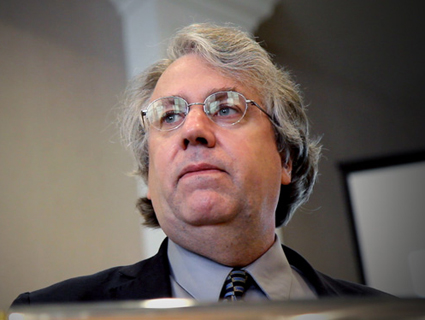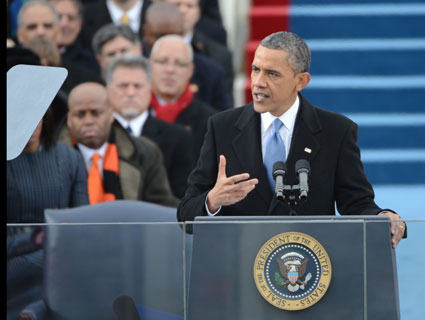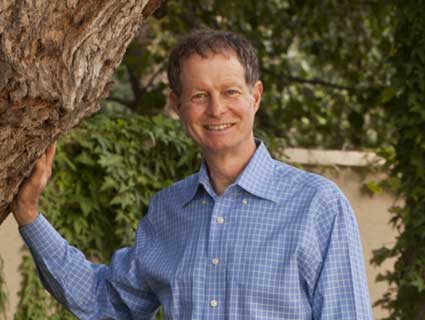UPDATE: Box is the featured guest at our ClimateDesk Live event in Washington, D.C. today. Watch it live:
Jason Box speaks the language of Manhattans. Not the drink—the measuring unit.
As an expert on Greenland who has traveled 23 times to the massive, mile thick northern ice sheet, Box has shown an uncanny ability to predict major melts and breakoffs of Manhattan-sized ice chunks. A few years back, he foretold the release of a “4x Manhattans” piece of ice from Greenland’s Petermann Glacier, one so big that once afloat it was dubbed an “ice island.” In a scientific paper published in February of 2012, Box further predicted “100 % melt area over the ice sheet” within another decade of global warming. As it happened, the ice sheet’s surface almost completely melted just a month later in July—an event that, in Box’s words, “signals the beginning of the end for the ice sheet.”
Box, who will speak at next week’s Climate Desk Live briefing in Washington, D.C., pulls no punches when it comes to attributing all of this to humans and their fossil fuels. “Those who claim it’s all cycles just don’t understand that humans are driving the cycle right now, and for the foreseeable future,” he says. And the coastal consequences of allowing Greenland to continue its melting—and pour 23 feet’s worth of sea level into the ocean over the coming centuries—are just staggering. “If you’re the mayor of Hamburg, or Shanghai, or Philadelphia, I think it’s in your job description that you think forward a century,” says Box. “They’re completely inundated by the year 2200.”
Unless, that is, something big changes—something big enough to start Greenland cooling, shifting its “mass balance” from ice loss to ice gain once again. But that would require us to reverse global climate change, in an ever-dwindling time frame for doing so.
Currently based at the Byrd Polar Research Center at Ohio State—with a joint appointment at the Geological Survey of Denmark and Greenland—Box got his research start while an undergraduate at the University of Colorado-Boulder. As a senior, he traveled north with the Swiss glaciologist Konrad Steffen. In subsequent years, as his scientific career developed, Box increasingly began to think outside of…his last name. Rather than waiting on funding agencies, he teamed up with Greenpeace on a series of expeditions to document, and also dramatize, the ice sheet’s melting. He also began to set up time lapse cameras to observe the ice as it declines, something captured in the new documentary Chasing Ice, which features Box’s work.
Today, Box is trying to understand the feedback loops that may be driving a melting of Greenland that is much faster and more dramatic than many scientists expected. Take, for instance, melting on the ice’s sheet surface: Warmer or melting ice (or just plain meltwater) absorbs more sunlight than does healthy, cold ice. So as warmer temperatures melt the ice, the ice sheet absorbs more solar heat—melting even more. Another example: As Greenland melts, the massive ice sheet, more than two miles above sea level at its highest point, slumps in altitude. When that happens, more of the ice sheet is bathed in the warmer atmospheric temperatures that are found at lower elevations. So—you guessed it—it melts more.
But Box is most intrigued by one of the processes occurring atop the ice sheet, on its surface. Last summer, wildfires torched large parts of the US West, and especially Box’s home state of Colorado. The soot from the fires traveled as far north as the Greenland ice sheet and, once deposited on the ice, these dark particles absorbed additional sunlight. Compounding this effect are the Arctic microbes that live off of impurities from soot—living longer as the ice warms, and releasing dark pigments to protect themselves from the sunlight.
“I’m sitting in LaGuardia on my way to Greenland, people riveted to the TV with news about fire across the US,” Box remembers. “It was really dramatic, but I’m like, ‘Hold on, we need to really measure the soot.” Thus was born the Dark Snow project, in which Box and colleagues are trying to crowd-fund an expedition to sample the ice at high elevations and determine just how much soot from global wildfires and pollution are amplifying Greenland’s melting.
The upshot of what they know so far is that Greenland is not only melting—it may be melting faster than anyone expected, including most scientists. And what’s more, we may be blowing past a point of irreversibility, where the world commits, irrevocably, to a level of sea level rise that, as it unfolds over the coming centuries, would devastate many coastal megacities.
Just consider one striking statistic from Box: The summer melt from Greenland in 2012 alone added a millimeter to the global sea level. And not only is that millimeter felt around the globe, but it is felt in specific places. For instance, it rode atop the wall of water that Superstorm Sandy pushed inland at New York and New Jersey.
And that’s just a tiny fraction of what’s to come. One recent scientific prediction suggested that 1.6 degrees Celsius (just under 3 degrees Fahrenheit) of temperature rise above pre-industrial levels might be enough to lock in Greenland’s complete melting. Greenland temperatures in summer have already risen a full degree Celsius since the year 2000, and if the soot-related and biological feedbacks that are Box’s current focus turn out to be big enough, the 1.6 degree threshold might also be too conservative.
In other words, Box’s boots-on-the-ground perspective on Greenland suggests that the models might be undershooting things—and all that water may be coming faster still.
In his inaugural address, President Obama put a strong focus on the issue of climate change, citing the “devastating impact of raging fires, and crippling drought, and more powerful storms.” But all of this pales in comparison to a global ocean containing what used to be Greenland. And that, Box says, should serve as a major wake-up call, since “there’s no doubt that if climate continued like in 2012, Greenland’s gone.”
On Monday, January 28 at 9:30am, Jason Box will be speaking at a Climate Desk Live event in DC. Read more about it here and RSVP to cdl@climatedesk.org















